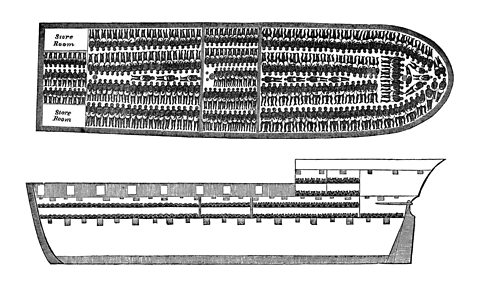Trade in enslaved Africans and the British economy
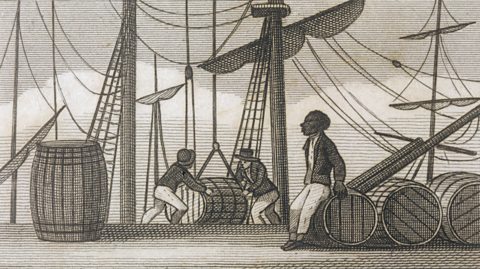 Image source, ALAMY
Image source, ALAMYQuick version
The British economy was boosted by the involvement in the trade in enslaved Africans and trade with the Caribbean plantations.
- British-made goods were sold in overseas markets
- Large profits were made selling enslaved Africans
- Trade in goods made in Caribbean plantations made British traders rich
British cities and ports became wealthy through trade associated with the buying and selling of enslaved Africans.
- London's banks provided financial services to the traders in enslaved Africans.
- Bristol became wealthy by trading in Caribbean sugar.
- Glasgow became wealthy trading in tobacco grown on plantations in the Americas
Learn in more depth
The trade in enslaved people and British industry
There was a growth in manufacturing industries that supplied slave traders. Demand grew for goods such as guns, alcohol, pots, pans, and textiles that were exchanged for captured Africans on the first leg of the Triangular Trade.
One major growth industry in Britain during this period was the textile industry. The trade in enslaved African people directly benefitted textile manufacturers;
- Enslaved labour provided cotton as a raw material.
- Imported cotton was turned into valuable textiles in British mills.
- These cotton textiles were then sold on the traders in Africa
Overall, British industry benefited from the trade in enslaved Africans in multiple ways:
- It boosted production of goods from British factories.
- It provided overseas markets for British-made goods.
- Banks and insurance companies sold insurance to slave merchants.
- Goods produced in British-owned plantations sold in European markets for profit.
Profits made in the trade of enslaved African people provided money for investment in British industry.
The Nigerian historian Joseph Inikori suggested that it was the trade in enslaved people which allowed the industrial revolutionA period of time during the 18th and 19th century where the UK shifted to becoming a much more industrial country relying more on machinery and the use of coal and oil. to happen and transform Britain into a world superpower.
The trade in enslaved people and British ports
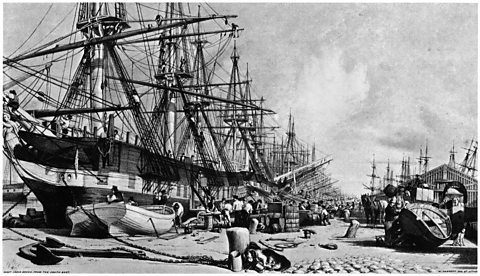 Image source, ALAMY
Image source, ALAMYThe work of enslaved people on the plantations generated huge profits and wealth for the merchants and ports involved, in both Britain and the Caribbean.
The main British ports involved in the trade in enslaved people all experienced periods of rapid growth and increasing wealth during the 18th century.
Between 1761 and 1807, British traders:
- Transported 1,428,000 captive African people across the Atlantic.
- Made around ÂŁ60 million from the trade in enslaved Africans (around ÂŁ8 billion in today's money).
The shipping industry grew enormously. Most of the British slaving ships were fitted in these ports. There was as much work involved in building, fitting and repairing the ships as in sailing them.
Liverpool became a major shipbuilding city as a result of the trade in enslaved people.
Trade with the Caribbean employed half of Britain’s long distance ships. Many ship owners involved in the trade in enslaved people were also plantation owners. Often profits were spent by merchants around their home ports.
 Image source, ALAMY
Image source, ALAMYLondon and the trade in enslaved Africans
The trade in enslaved people and London's banks
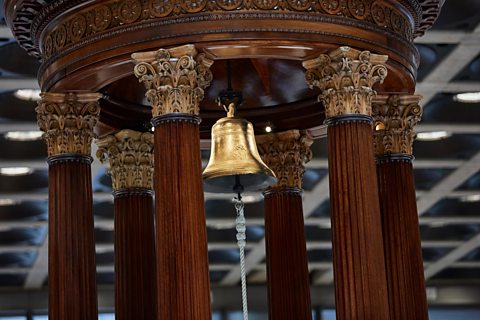 Image source, ALAMY
Image source, ALAMYThe Bank of England made capital available for slave voyages and the City of London became the financial centre of the trade in enslaved people.
Banks and financial institutions such as Lloyds of London and Barclays offered financial services such as loans and insurance to merchants:
- The bank loans funded merchants to buy and fit out ships to trade with the New World.
- Trading ships could take over a year to return to Britain so bank loans covered day-to-day costs for traders.
- Ships and cargo could be lost in storms. Insurance covered the cost of any losses.
 Image source, ALAMY
Image source, ALAMYThe Royal Africa Company
In 1672 the Royal Africa Company was formed by King Charles II and London merchants.
- The company had a monopoly on the trade of enslaved people, gold, and goods from West Africa.
- Between 1672 and 1689, the company transported around 100,000 African people into slavery.
- The gold it supplied to the Royal Mint was named the guinea, after the West African country the gold came from.
In 1689 the Royal Africa Company lost its monopoly on the slave trade and merchants from other British cities began to get more involved in the trade.
The West Indian Interest group
The West India Interest was a political group formed in the 1740s when British merchants joined forces with West Indian sugar planters.
For much of the 18th century, the British colony of Barbados was the richest of all the European colonies in the Caribbean region because of the profits from its sugar plantations.
British merchants grew rich trading with the plantations. The merchants and plantation owners formed a political alliance to protect their interests.
The West India Interest was the first sugar trading organisation to have a significant voice in Parliament. For example, in 1789 an assembly of planters from Jamaica visited Parliament to lobby MPs in support of the slave trade.
Bristol's sugar industry
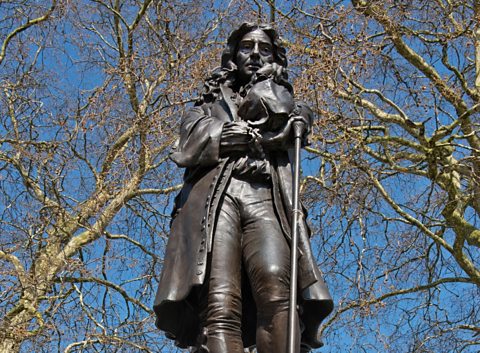 Image source, ALAMY
Image source, ALAMYSugar was the most profitable of Bristol's industries – at one time Bristol had 22 sugar houses. These refineries were to process the crude sugars shipped across the Atlantic from the Caribbean plantations.
Bristol was home to groups of prosperous sugar merchants, as well as West Indian planters who returned 'home' to retire to grand houses in the West Country.
Bristol still contains important architectural monuments to its links with sugar and the slave trade.
- Pero's Bridge was named after an enslaved person brought to Bristol from St Kitts by the famous planters, the Pinneys.
- Guinea Street and the Merchants' Hall were all built with profits gained from the trading of enslaved people.
 Image source, ALAMY
Image source, ALAMYGlasgow's tobacco industry
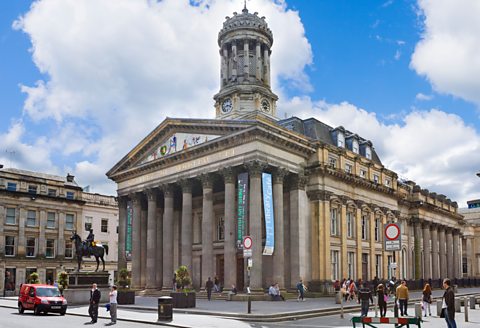 Image source, ALAMY
Image source, ALAMYGlasgow boomed during the 18th century with profits from the slave trade.
A small group of Glaswegian merchants dominated the rapidly expanding transatlantic tobacco trade. These Scottish merchants became known as 'Tobacco Lords'.
They created tobacco trading networks in Virginia and by 1760 Glasgow had overtaken London as the main importer of tobacco.
Many of the old streets of Glasgow are named after Tobacco Lords.
- Buchanan Street
- Glassford Street
- Ingram Street
- Dunlop Street
 Image source, ALAMY
Image source, ALAMYTest what you have learned
Quiz
Recap what you have learned
The British economy benefited from Caribbean colonies and involvement in the trade in enslaved Africans:
- Enslaved labour produced raw materials that allowed British factories to grow.
- British factory goods had large overseas markets.
- Trade in enslaved Africans made merchants rich.
- British banks provided loans and insurance to merchants involved in the trade in enslaved people.
- Trade in products made by enslaved Africans generated wealth for British ports and cities.
- Ports such as Glasgow, Liverpool, and Bristol grew from small port towns to large cities due to involvement in trade in enslaved people.
- Industries such as shipbuilding grew due to the demand for ships to trade in goods related to the trade in enslaved people.
British merchants and Caribbean plantation owners joined forces and formed lobby groups to petition the UK Parliament to protect their business interests and defend the trade in enslaved Africans.
More on Trade in enslaved African people
Find out more by working through a topic
- count10 of 10

- count1 of 10
